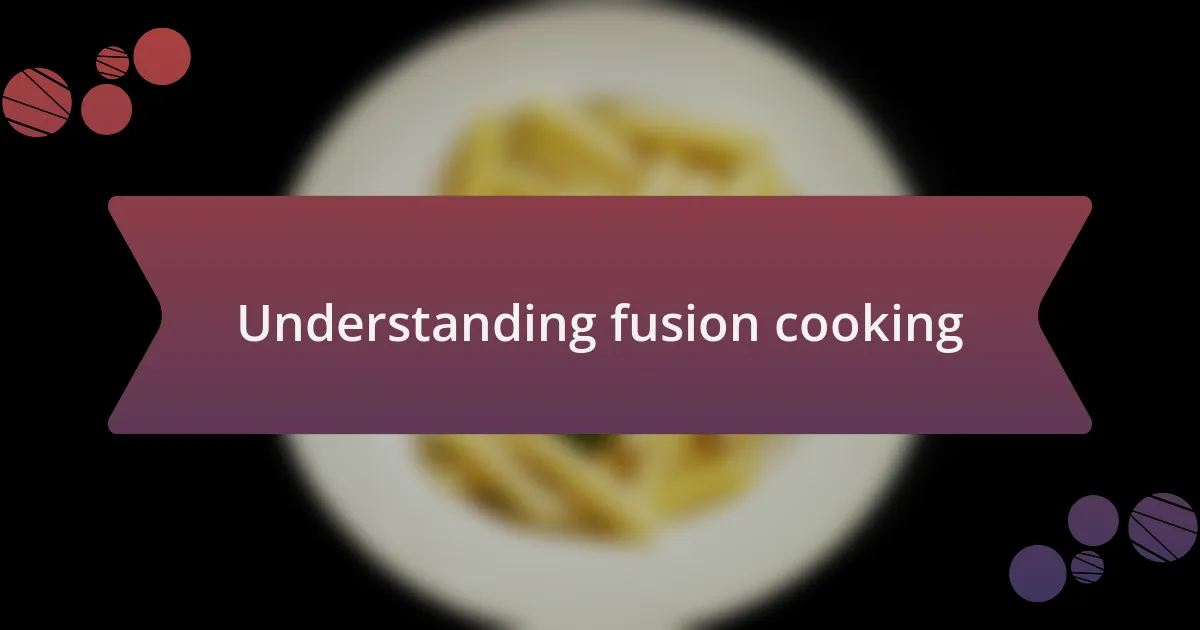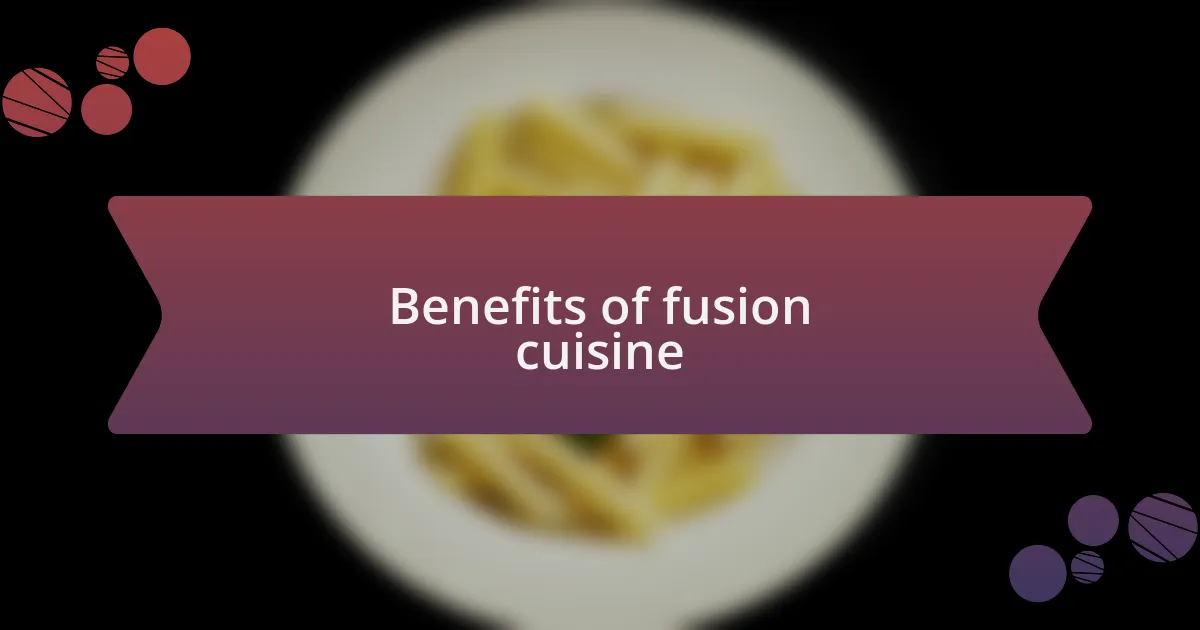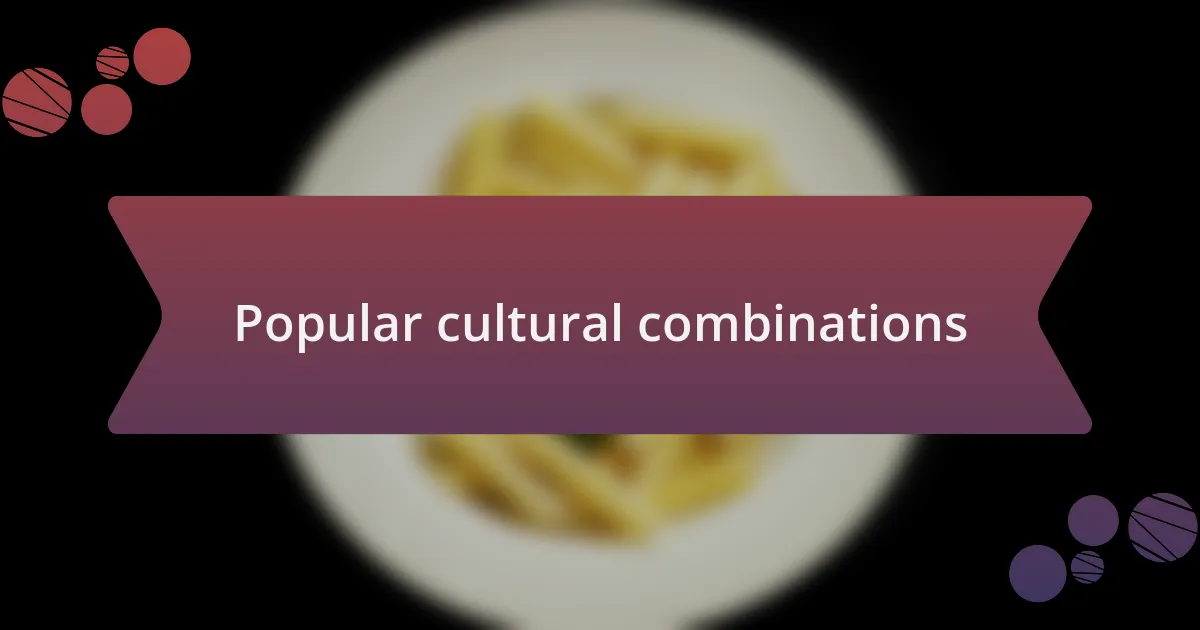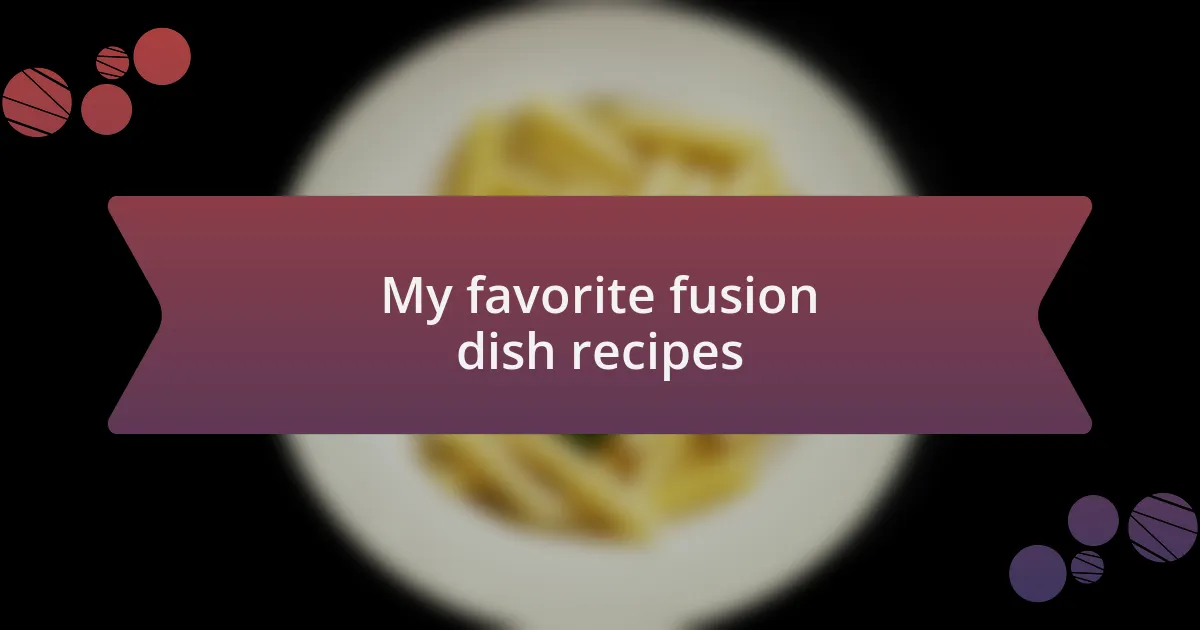Key takeaways:
- Fusion cooking is a creative blend of different cuisines that encourages innovation and respect for cultural origins.
- Benefits of fusion cuisine include expanded flavor profiles, cultural appreciation, and adaptability to diverse dietary needs.
- Key techniques for merging flavors involve balancing contrasting elements, layering flavors, and using infusions for enhanced culinary experiences.
- Personal fusion dish recipes illustrate the potential of combining distinct cuisines to create unique and satisfying meals.

Understanding fusion cooking
Fusion cooking is more than just a blend of different cuisines; it’s a creative expression where flavors collide and cultures intermingle. I remember the first time I paired Thai basil with Italian pasta—it was an experiment that felt daring yet satisfying, as if I were crafting a culinary bridge between two worlds. Have you ever tasted something unexpected that made you rethink traditional flavors?
At its heart, fusion cooking encourages innovation and flexibility in the kitchen. I often find myself inspired by local ingredients, mixing them with global techniques. The other day, I sautéed carrots in a spicy jerk seasoning, and the sweet and heat combination sparked a flavor journey that felt both familiar and new. Isn’t it thrilling to see how diverse influences can come together to create something truly unique?
Understanding fusion cooking also involves respecting the origins of the ingredients and dishes you combine. I once attended a workshop where the chef emphasized that even while blending, we should be aware of the cultural significance behind each element. This perspective deepened my appreciation for the dishes I create and often leads me to ask—how can I honor tradition while being adventurous in my cooking?

Benefits of fusion cuisine
One of the most compelling benefits of fusion cuisine is its ability to broaden our culinary horizons. When I first tried blending Indian spices with classic Mexican flavors, it opened up a new world of taste possibilities. Can you imagine the warmth of cumin alongside the zest of lime in a taco? This kind of experimentation invites creativity that can reignite passion in even the most seasoned cook.
Beyond just expanding flavor profiles, fusion cuisine encourages cultural appreciation and connection. I remember hosting a dinner party where I featured a Moroccan-inspired paella, merging saffron with preserved lemons. Guests were fascinated, asking questions about the origins of the ingredients. This gave me the chance to share stories about their cultural significance and sparked enriching conversations that transcended the meal.
Another powerful advantage lies in adaptability; fusion dishes can cater to diverse dietary needs and preferences. My experience with gluten-free cooking led me to create a quinoa risotto, marrying traditional Italian techniques with ingredients that suit modern diets. Have you ever found a dish that meets everyone’s needs? It’s a relief to know that innovation can bridge gaps and make dining inclusive while still being delicious.

Popular cultural combinations
When thinking about popular cultural combinations, one that always stands out to me is the delightful marriage of Korean and American flavors. I remember the first time I bit into a bulgogi burger; the savory marinated beef paired with tangy kimchi on a classic burger bun was an explosion of flavors. Can you imagine biting into that harmony of textures and tastes? It’s one of those combinations that truly highlights how different influences can create something entirely unique and satisfying.
Another fascinating blend I love is the combination of Japanese and Italian cuisines. One evening, I ventured to make a miso carbonara and was pleasantly surprised by how the umami from the miso added depth to the traditional creamy sauce. While some might question this unconventional pairing, I found that it brought a new twist to a classic dish while still respecting both cultures. Have you ever experimented with a flavor profile that seemed odd at first but worked perfectly?
On a more adventurous note, I often play with the fusion of Thai and Indian flavors, crafting dishes like green curry dal. The spiciness of Thai basil combined with lentils creates a comforting dish that tells a story of both cultures. I recall serving this at a family gathering, and watching everyone’s eyes light up with curiosity and enjoyment was truly rewarding. Which cultural combination will inspire your next cooking adventure?

Selecting ingredients for fusion
Selecting ingredients for fusion cuisine is an art in itself. It requires a thoughtful approach to ensure that flavors complement rather than clash. I often think about the bold spices of Indian cuisine, like garam masala, and how they can elevate a simple Italian risotto. Have you ever tried blending these distinct elements together? The result can be a comforting masterpiece that speaks to both cultures.
When I select ingredients, I also consider the textures at play. A few months ago, I created a dish that combined crispy tempura vegetables with creamy ricotta spread on a crusty baguette. The contrast was delightful, providing a balance that made every bite an adventure. Which textures make your taste buds dance with joy?
It’s essential to source quality ingredients, too. I remember visiting a local market to find fresh herbs for a Mediterranean-Asian fusion salad. The vibrant cilantro and fragrant basil not only enhanced the flavor but also added a burst of color to the dish. Have you explored your local markets? Sometimes the best inspiration comes from the freshest finds right in your community.

Techniques for merging flavors
When it comes to merging flavors, balance is key. I remember experimenting with a Korean barbecue-inspired taco by blending spicy gochujang with tangy lime and cilantro. The moment I took my first bite, the explosion of flavors was electrifying, proving that contrasting elements can create a harmonious dish. How do you find that perfect balance in your own cooking experiences?
Another powerful technique is layering flavors throughout the cooking process. Recently, I prepared a dish that used a base of aromatic Thai green curry and added hints of Italian pesto as a finishing touch. This approach allowed the flavors to build, resulting in a dish that was both familiar and entirely new. Have you thought about how layering could change the outcome of your favorite recipes?
Infusion is another exciting technique, where I often create flavored oils or stocks to enhance my dishes. Once, I made a vibrant saffron-infused olive oil that I drizzled over a Mediterranean paella. The infusion not only intensified the flavor but also brought a visual allure to the dish. How might an infused element transform the way you experience your favorite flavors?

My favorite fusion dish recipes
One of my favorite fusion dishes is a Mediterranean sushi roll. I vividly remember my first attempt, where I filled sushi rice with roasted red peppers, feta cheese, and a touch of olive tapenade. Each bite was a delightful surprise—a blend of sushi’s delicate texture with the bold flavors of the Mediterranean. Have you ever wondered how combining such distinct cuisines could open up new culinary horizons for you?
Another dish I cherish is my take on a classic Mexican enchilada, where I introduced a coconut curry sauce in place of the traditional red sauce. I was a bit apprehensive at first, but the moment the creamy, spicy sauce enveloped the enchiladas, I was transported to a flavor paradise. The unexpected twist was both comforting and exhilarating. Have you ever taken a cherished recipe and given it a surprising twist?
Lastly, I have an obsession with creating a spicy kimchi quesadilla. I was inspired by a late-night craving and decided to layer gooey cheese over spicy kimchi and mushrooms in a tortillas. The crunch with the melty goodness was absolutely irresistible! It’s fascinating how one simple substitution can lead to such a satisfying experience. What flavors would you explore to transform your everyday meals?